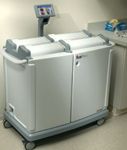This new product helps dispose of drug waste
The basic principle of health-care treatment-"First, do no harm"-should apply also to the proper disposal of hazardous pharmaceutical waste. A new product, EcoRex, from Vestara in Irvine, Calif., is designed to achieve that end, using customized software to reduce the potential harm of such waste.

"In many hospitals and clinics, the standard procedure for disposal of numerous unused pharmaceuticals has been simply to pour them down the drain," said Russell F. Mankes, Ph.D., a chemical hygiene officer at the Albany Medical Center who has studied the risks associated with health facility waste disposal systems. "That is a critical public health issue, so both federal and state regulations have been developed prohibiting this with respect to dangerous drugs. But there remains a lack of awareness on the part of many healthcare professionals of the laws and best practices."

EcoRex is designed to avoid state and RCRA violations and at the same time enhance environmental and health-system safety, said company officials. Its software uses bar-code technology to classify and separate waste into secure containers. The product recently completed beta testing at 10 hospitals and will be rolled out this May. "Our goal was to provide a total solution to this problem," said Steve Johnson, marketing VP. "We improved our software during the testing process. The units are beneficial to virtually any hospital of any size."
Currently, most hospitals use manual identification of pharmaceutical waste, based on the Food & Drug Administration's National Drug Codes (NDC), to sort products for disposal. "That approach is time-consuming, especially in light of complicated state and federal hazardous waste regulations, and is more unsafe than an automated system," said Johnson. "The average nurse, for instance, may handle 50 to 240 medications a day. How can nurses be expected to identify, sort, and properly dispose of every pharmaceutical encountered?"
Vestara developed software that interfaces with virtually all pharmacy software. "That in itself is a huge challenge," said Johnson. In addition, the software allows a 2D bar code to be printed on uniquely generated admixture labels. "Our research showed that only about 20% of the nation's hospitals have bedside bar-scanning capabilities," he said. "We wanted a broader solution."
One of the beta test sites was Riverside Methodist Hospital in Columbus, Ohio. Its test lasted several months last year, said Brendan Reichert, R.Ph., clinical applications manager for information services at OhioHealth, which owns the 1,100-bed Riverside.
"One thing we liked about EcoRex right away was that it is fully HL-7 compatible," said Reichert. "This meant that if we created an admixture, a message was sent to EcoRex. When the nurse disposed of the compound, the unit was ready to direct the admixture waste [to the proper container]. Nurses can be very busy and make mistakes about [proper] disposal. The unit is designed specifically to avoid that." (HL-7 is an acronym for Health Level 7, the interface standard for communication between various software systems employed in the medical community.)